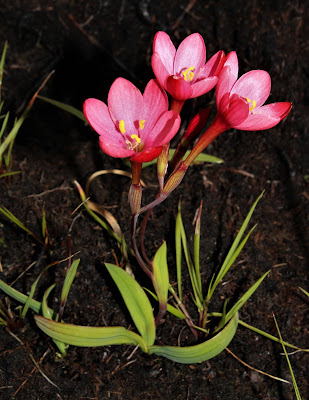 |
| Geissorhiza seracina Goldblatt & J.C.Manning, in Goldblatt, Manning et du Preez, 2022. |
Highlights:
• Geissorhiza seracina is described.
• It is a local endemic of the eastern Langeberg.
• It is illustrated by colour photographs.
• It is distinguished from G. altimontana by a longer perianth tube and filaments.
Abstract
The new species Geissorhiza seracina Goldblatt & J.C.Manning (Iridaceae: Crocoideae) is known from a single locality on the central Langeberg Mountains in Western Cape, South Africa. Discovered in December 2021, G. seracina is restricted to high altitude seepages in peaty soils. The soft corm tunics and moderately large, deep pink flowers suggest that it is allied to another Langeberg endemic, G. altimontana Goldblatt & J.C.Manning of subg. Weihea sect. Weihea, but it differs from that species in lacking fibrous leaf bases, in its mostly fewer leaves, and in its flowers, which have a longer perianth tube 18–23 mm long, with longer filaments, 11–12 mm long, inserted well below the mouth of the tube. It is illustrated by colour photographs. In addition, re-examination of collections of the poorly collected G. outeniquensis Goldblatt necessitates that the recorded length of the perianth tube for that species be significantly extended. Originally recorded as 10–13 mm long, the perianth tube in G. outeniquensis is now determined to be (10–)13–20 mm long.
Keywords: Cape Flora, New taxa, Taxonomy, Systematics
Geissorhiza seracina Goldblatt & J.C.Manning
Etymology: Geissorhiza seracina is named for the cherry-pink flowers.
P. Goldblatt, J.C. Manning and B. du Preez. 2022. Geissorhiza seracina (Iridaceae: Crocoideae), A New High-altitude Species from the Langeberg in southwestern Western Cape, South Africa, with notes on G. outeniquensis. South African Journal of Botany. 150; 1022-1025. DOI: 10.1016/j.sajb.2022.09.014

